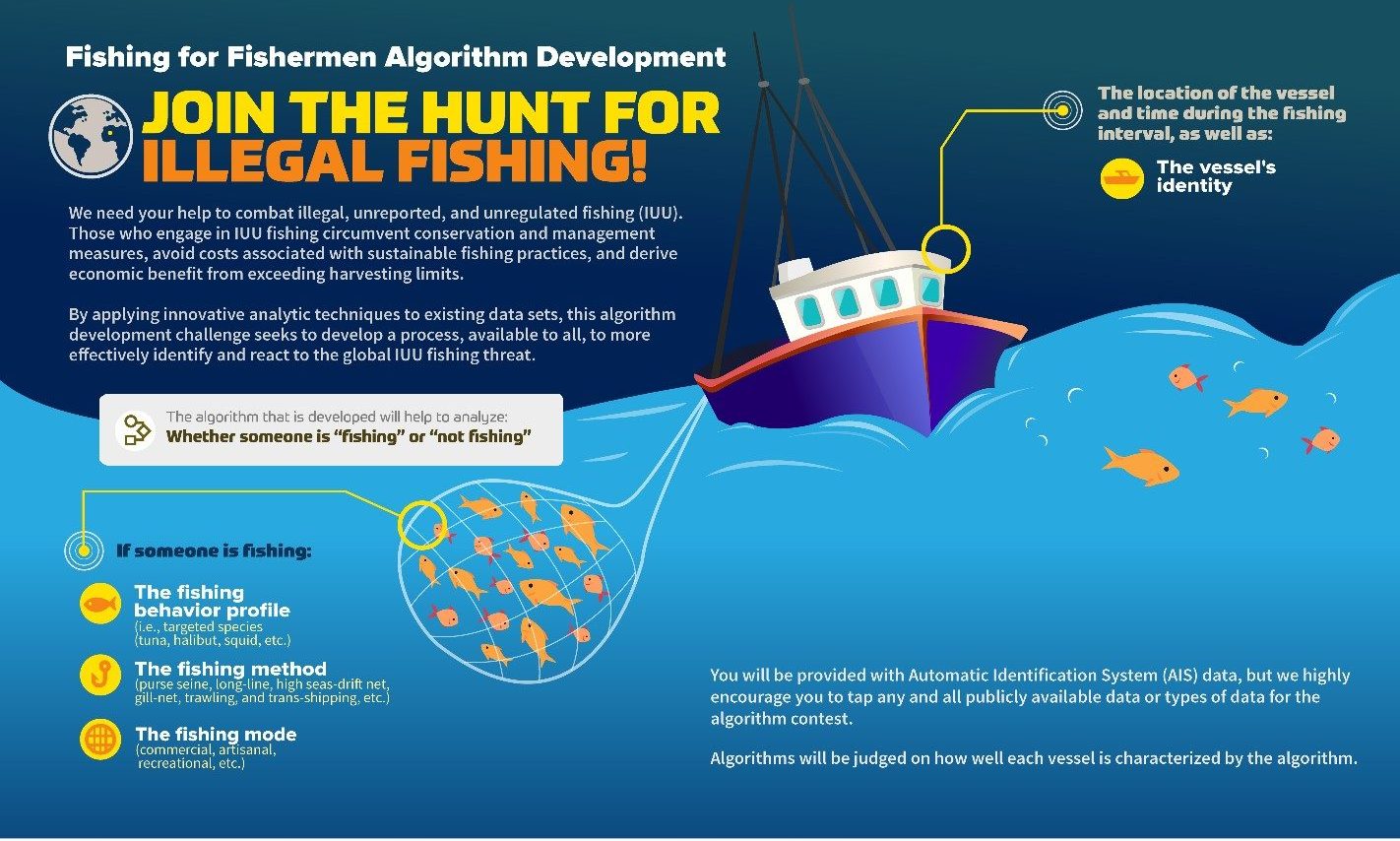"Fishing for Fishermen" Maritime Data Challenge
National Maritime Intelligence Integration Office (NMIO)
Summary
On Sept. 8, 2017, NMIO completed the "Fishing for Fishermen" Maritime Data Challenge, a worldwide crowdsourcing algorithm development competition that sought to develop a method that would enable authorities to more effectively identify and respond to illegal, unregulated, and unreported (IUU) fishing activity around the world.

The Maritime Data Challenge also relied on crowdsourcing to develop an information graphic explaining the purpose of the competition, and why it was important. (Photo courtesy of NMIO)
Those who engage in IUU fishing derive economic benefit by circumventing conservation and sustainable fishing harvest limits, thereby inflicting serious environmental harm. By applying innovative analytic techniques to existing data sources, the competition sought to develop a process to more effectively identify and react to the global IUU fishing threat. The goal was to make the process available to all authorities worldwide.
The Data Challenge was managed by Topcoder and co-sponsored by the U.S. Department of Defense and Department of Homeland Security. NMIO partnered with the NASA and the Harvard University Crowd Innovation Lab to manage the competition.
The competition, run in two phases over two years, attracted 119 contestants from 33 countries.
NMIO and its partners also used crowdsourcing to develop the information graphic explaining the purpose of the competition, and why it was important. The winning entry was selected from more than 10 submissions, and was chosen because it clearly explained what we were seeking, and why it was important, thereby encouraging those competitors to participate in order to help protect the environment and address a problem that is not necessarily well-publicized or widely appreciated. This graphic also ensured that all of the participating agencies and offices were recognized for their efforts.
Results
The first phase of the competition, Marathon Match I, was designed to identify which vessels in 10 pre-selected fishing areas were engaged in fishing. Marathon Match I attracted 77 competitors. The winning algorithm had an accuracy rate above 98 percent.
The second, more complex phase, Marathon Match II, involved 56 active competitors and sought to determine the type of fishing activities the vessels were engaged in. The winning algorithm had the following accuracy rates for the specified fishing type:
- Support – 97-98 percent
- Long-liner – 96-97 percent
- Trawler – 95 percent
- Seiner – 91-92 percent
Areas of Excellence
Area of Excellence #1: "Build a Team"
By partnering with U.S. Government agencies, academia, and industry, NMIO was able to build a team of maritime stakeholders who were interested in addressing the problem of IUU fishing around the world.
The use of crowdsourcing allowed NMIO and its Data Challenge partners to, in turn, gain access to some of the world's leading algorithmic scientists for a fraction of the cost required to either hire such talent or to contract for it through an established vendor. For an investment of under $250,000 over a two-year period (less than the cost for one full-time equivalent, or FTE), NMIO and the Data Challenge Team were able to tap into experienced data scientists across the globe who delivered highly accurate algorithms that can be used by fishery analysts and enforcement authorities globally to support their efforts in combating IUU fishing.
Area of Excellence #2: "Share Best Practices and Results"
From the beginning, our intent was to make the winning algorithms publically available to enable analysts and enforcement personnel globally to more effectively identify and react to the global IUU fishing threat. The winning algorithms and supporting documentation are available on GITHUB.
In September 2017, NMIO partnered with the Stimson Center, Waitt Foundation, and National Geographic to host partners Costa Rica and Chile for a workshop focused on identifying ways to combat IUU fishing within these partner nations' waters. At this event, NMIO announced the winners of the challenge competitions, provided participating stakeholders the GITHUB information, and requested feedback from any stakeholder using the algorithms.
Earlier this month, one of our challenge partners briefed our effort to more than 120 maritime stakeholders at the Global Maritime Forum, held at California State University – Maritime in Vallejo, Calif. As a result of that presentation and the interest it created, we are exploring how best to capture metrics and feedback from the stakeholders using the algorithms.
Challenge Type: Algorithms, Visualizations, and Analytics
The use of crowdsourcing yielded algorithms that were surprisingly accurate and reliable in their ability to identify fishing activity, and then to help identify the type of that activity. Once transmitted to authorities in a usable format, this will allow them to best identify and respond to suspected illegal fishing activity, and to make the best decisions regarding limited and valuable resources. Crowdsourcing also allowed NMIO to have the leading results peer-evaluated to ensure their reliability and validity.
Legal Authority
Title II of the America COMPETES Reauthorization Act (Public Law 111-358), through our partners at NASA.
Challenge Website
https://community.topcoder.com/tc?module=MatchDetails&rd=16978

